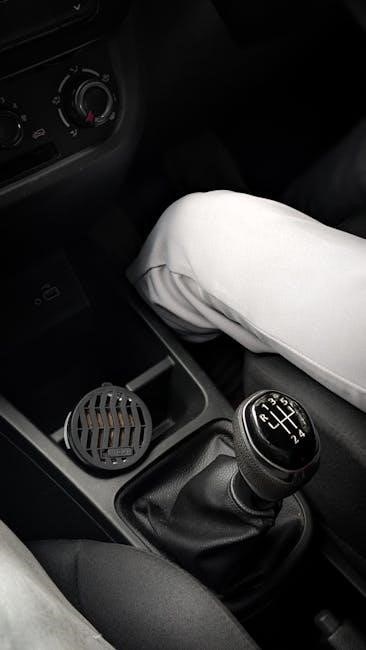Manual transmission sticking occurs when gears fail to engage properly, causing problems with shifting and vehicle control, often due to wear and tear on transmission components, affecting overall vehicle performance and safety naturally․
Understanding the Basics of Manual Transmission
Manual transmission is a type of transmission that allows drivers to manually change gears using a clutch pedal and a gearshift․ The manual transmission system consists of various components, including the clutch, gearbox, and transmission shafts, which work together to provide smooth and efficient gear shifting․ Understanding the basics of manual transmission is essential to identify and address any issues that may arise, including sticking problems․ The manual transmission system is designed to provide drivers with more control over the vehicle, allowing them to adjust gear ratios to suit different driving conditions․ The clutch pedal plays a crucial role in the manual transmission system, as it disconnects the engine from the transmission, allowing drivers to shift gears smoothly․ The gearbox, on the other hand, contains the gears and bearings that transmit power from the engine to the wheels․ By understanding how these components work together, drivers can better appreciate the importance of proper maintenance and repair to prevent sticking and other problems․ Regular maintenance, such as checking transmission fluid levels and replacing worn-out components, can help prevent sticking and ensure smooth gear shifting․
Importance of Addressing Transmission Issues
Addressing transmission issues, including manual transmission sticking, is crucial to ensure the safety and reliability of a vehicle․ According to the National Highway Traffic Safety Administration, mechanical failures, including transmission problems, are a leading cause of vehicle accidents․ Failing to address transmission issues can lead to further damage to the vehicle, resulting in costly repairs and potentially putting the driver and passengers at risk․ Regular maintenance and prompt repair of transmission problems can help prevent accidents and ensure the vehicle operates smoothly․ The importance of addressing transmission issues cannot be overstated, as it can have serious consequences if left unattended․ By prioritizing transmission maintenance and repair, drivers can help prevent sticking and other problems, reducing the risk of accidents and ensuring their vehicle remains in good working condition; This, in turn, can provide peace of mind and help drivers stay safe on the road․ Proper transmission maintenance is essential for vehicle safety and reliability․

Common Causes of Manual Transmission Sticking
Manual transmission sticking occurs due to various factors affecting transmission performance and safety naturally every day․ Some factors include wear and tear on components over time slowly․
Low or Degraded Transmission Fluid
Low or degraded transmission fluid is a common cause of manual transmission sticking, as it can lead to increased friction and wear on transmission components․ The transmission fluid plays a crucial role in lubricating the gears and other moving parts, and if it is low or degraded, it can cause the transmission to stick or hesitate․ This can be due to a variety of factors, including lack of maintenance, high mileage, or extreme temperatures․ If the transmission fluid is not changed regularly, it can become contaminated with dirt and debris, which can cause the transmission to stick․ Additionally, if the transmission fluid level is low, it can cause the transmission to overheat, leading to further damage․ It is essential to check the transmission fluid level regularly and change it as recommended by the manufacturer to prevent manual transmission sticking․ Regular maintenance can help to prevent this issue and ensure smooth transmission performance․
Clutch System Issues
Clutch system issues can also cause manual transmission sticking, as the clutch plays a crucial role in engaging and disengaging the transmission․ If the clutch is worn or damaged, it can cause the transmission to stick or hesitate, making it difficult to shift gears․ The clutch system consists of several components, including the clutch disc, pressure plate, and release bearing, and any problems with these components can cause the transmission to stick․ For example, if the clutch disc is worn, it may not disengage properly, causing the transmission to stick in gear․ Similarly, if the release bearing is damaged, it can cause the clutch to engage prematurely, leading to transmission sticking․ Regular maintenance of the clutch system, including replacement of worn or damaged components, can help to prevent manual transmission sticking and ensure smooth transmission performance․ By addressing clutch system issues promptly, drivers can avoid more serious transmission problems and ensure their vehicle runs smoothly․ Proper clutch system maintenance is essential for preventing transmission sticking․
Shift Lock Solenoid Problems
Shift lock solenoid problems can cause manual transmission sticking, as the solenoid plays a critical role in controlling the transmission’s shifting mechanism․ The shift lock solenoid is an electronic component that helps to engage and disengage the transmission’s gears, and if it fails, the transmission can become stuck in a particular gear․ This can be caused by a variety of factors, including electrical issues, worn or damaged solenoid components, or software problems․ If the shift lock solenoid is not functioning properly, it can prevent the transmission from shifting smoothly, leading to sticking or hesitation․ In some cases, the problem may be intermittent, making it difficult to diagnose․ A faulty shift lock solenoid can be replaced or repaired, depending on the nature of the problem․ Regular maintenance and inspection of the transmission’s electronic components can help to identify and address shift lock solenoid problems before they cause manual transmission sticking․ By addressing these problems, drivers can ensure their vehicle’s transmission operates smoothly and efficiently․ The shift lock solenoid is a critical component that requires regular maintenance to prevent transmission sticking․

Symptoms of a Stuck Manual Transmission
Transmission sticking causes grinding noises, vibrations, and difficulty shifting, affecting vehicle performance and safety naturally always․
Stiffness in the Gear

Stiffness in the gear is a common symptom of a stuck manual transmission, where the gear becomes difficult to shift, causing discomfort and affecting the overall driving experience․ This stiffness can be due to various reasons, including wear and tear on the transmission components, low transmission fluid levels, or problems with the clutch system․ As a result, drivers may experience difficulty shifting gears, particularly when trying to shift into higher gears․ The stiffness can also cause the gear to hesitate or stick, making it challenging to control the vehicle․ In some cases, the stiffness can be accompanied by other symptoms, such as grinding noises or vibrations, which can further indicate a problem with the manual transmission․ It is essential to address the issue promptly to avoid further damage to the transmission and ensure safe driving․ Regular maintenance and checks can help identify and resolve the problem before it becomes a significant issue․
Transmission Stuck in Gear While Driving
When a manual transmission becomes stuck in gear while driving, it can be a frightening and potentially dangerous experience․ The vehicle may refuse to shift out of a particular gear, causing the engine to rev excessively or the vehicle to lose power․ This can lead to a loss of control, especially when driving at high speeds or in heavy traffic․ In such situations, it is crucial to remain calm and take immediate action to avoid an accident․ The driver should take their foot off the accelerator and try to coast to a safe location, such as the side of the road or a parking lot․ Once in a safe location, the driver can attempt to troubleshoot the issue or seek assistance from a professional mechanic․ It is essential to address the problem promptly to avoid causing further damage to the transmission or other components of the vehicle․ Regular maintenance and inspections can help prevent such issues from occurring in the future․

Troubleshooting a Stuck Manual Transmission
Troubleshooting involves identifying symptoms, checking fluid levels, and inspecting components to determine the cause of sticking, taking necessary steps to repair or replace faulty parts quickly and efficiently always․
Emergency Fixes for a Stuck Manual Transmission
In emergency situations, drivers may need to take temporary measures to get their vehicle to a safe location or a repair shop․ This can include shifting into neutral and restarting the engine, or using the parking brake to help disengage the stuck gear․ It is essential to remain calm and avoid forcing the gearshift, as this can cause further damage to the transmission․ Drivers should also avoid driving the vehicle if it is not safe to do so, as this can lead to more severe problems and potentially cause an accident․ By taking the right emergency measures, drivers can minimize the risk of further damage and get their vehicle back on the road as soon as possible․ Emergency fixes are not a permanent solution, but they can help in a difficult situation, and it is crucial to have the vehicle properly repaired as soon as possible to prevent further issues․
Advanced Troubleshooting Steps for Manual Transmissions
Advanced troubleshooting steps for manual transmissions involve a more detailed examination of the transmission components and systems․ This includes inspecting the clutch and pressure plate for wear and damage, checking the gear teeth for signs of wear or cracking, and examining the shift linkages and cables for damage or misalignment․ Additionally, technicians may use specialized tools to measure the transmission’s gear clearance and backlash, and to check the condition of the bearings and seals․ By performing these advanced troubleshooting steps, technicians can identify and repair complex problems with the manual transmission, such as issues with the synchronizers or gear sets․ This can help to restore smooth and reliable shifting, and prevent further damage to the transmission․ Advanced troubleshooting requires a high level of technical expertise and specialized equipment, and is typically performed by experienced mechanics or transmission specialists in a well-equipped repair shop․

Leave a Reply
You must be logged in to post a comment.